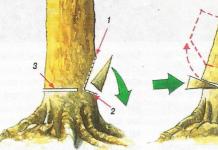Chinese cabbage- unpretentious agricultural crop, which is easy to grow on your own personal plot... Due to the short growing season, up to two harvests of this vegetable can be obtained in one season. The plant takes root in almost any type of soil and does not require complex care and regular feeding. In this article, we will look at the processes of growing Chinese cabbage from seeds and planting in open ground.
The seedling method is preferred in regions with cold springs and late summer. Plus, this method avoids the formation of arrows and accelerates the formation of a head of cabbage. To obtain a summer harvest, seeds must be planted in late March or early April, in order to obtain cabbage for winter storage, seedlings are formed towards the end of June.
Selection and preparation of seeds
It is correct to buy planting material for growing only in specialized stores, since storage conditions are observed there. On the packaging, you need to carefully check the expiration dates and the suitability of the variety for your region, as well as the planned ripening time.
Before planting, the seeds must be carefully selected, and then disinfected in a 1% solution of potassium permanganate for 30-40 minutes. There is also a dry method - for this they need to be kept in the open sun for 5-7 days.
When growing Chinese cabbage in infertile soil, it is recommended to additionally process them with stimulating drugs. For this purpose, Rizoplan, Trichodermin or Immunocytophyte are used.
Preparation of soil and containers
Peking cabbage is best grown in acidic or neutral soils, so it is best to use a mixture of turf and peat in equal proportions as a soil for growing seedlings. It can be replaced with humus and coconut substrate in a 1: 2 ratio.
If you are preparing turf soil at home, then it is advisable to disinfect it with a 1% solution of potassium permanganate, and then pour abundantly with warm water.
Sowing seeds and caring for seedlings

Seeds for cultivation are sown in individual containers of 3-4 pieces to achieve 100% germination. The seed is planted in the prepared soil to a depth of 0.5 cm, and then sprinkled on top. After that, they must be poured abundantly with warm water and removed to a warm place where there is no direct exposure to sunlight. At this stage, it is permissible to close the sowing with plastic wrap, which it is advisable to remove during the day.
The first shoots are formed 3-5 days after planting. Containers with seedlings must be taken out to the light, and also observed temperature regime... The most optimal temperature for the growth of seedlings is 18-20 degrees. Throughout the entire growth, it is necessary to use an additional light source, for which it is most convenient to use artificial lighting lamps placed on top of the seedlings.
Watering should be carried out as the top layer dries, for this it is advisable to use only clean and warm water. As soon as 2-3 healthy leaves are formed in the seedlings, it should be thinned out, leaving one of the healthiest plants in containers. The procedure must be carried out carefully so as not to damage the root system of the main seedling.
Top dressing is carried out only once after the formation of the first leaves. For this purpose, potash fertilizers (2 grams per 1 liter of water) or superphosphates (4 grams per 1 liter) are used. One liter of top dressing is enough for 50-60 seedlings.
Landing in the ground

It is not recommended to pick seedlings, since Peking cabbage does not tolerate this process well. After the formation of 4-7 strong leaves (it takes 25-30 days), the seedlings can be transplanted into open ground. Before this, you should prepare the site, as a soil it is advisable to choose a place with acidic or neutral soil, on which root crops or legumes previously grew.
Seedlings need to be hardened before planting - 2-3 weeks before that, they should be regularly taken out into fresh air and gradually increase the procedure time. A few days before transplanting, the seedlings are recommended to be kept outdoors, and also to completely stop watering.
Peking cabbage is planted in the garden in separate holes at a distance of about 25 cm from each other or using a checkerboard method. After this, the plants should be covered with a substrate, watered abundantly with warm water and mulching.
Outdoor cultivation

The plot in the country where Chinese cabbage is grown should be well lit, the plant prefers acidic or neutral loose soils. It is advisable to observe crop rotation - roots and legumes are considered the best predecessors of cabbage.
The plant grows and matures quickly, so you can get two crops in one season. Early disembarkation is carried out on April 15-20, in cold regions - until March 20. The second landing is permissible from July 20-25 to August 10-15, in areas with cold summers, the dates can be shifted by 7 days.
At the same time, it is important to take into account the characteristics of the variety. Early hybrids are ready for harvesting in 40-50 days, and late ones only in 70-80 days. Mid-season varieties are often used; they yield in 55-60 days.
Soil preparation and planting seeds
Before planting, the soil must be completely dug up and cleaned of weeds. In disadvantaged areas, it is advisable to add ammonium nitrate or superphosphate during this process. Cabbage is planted in separate holes, at a distance of 25-30 cm from each other, before planting, add 300 grams to it. humus or compost, as well as 2-3 tablespoons of ash, and then pour abundantly with water.
Pre-disinfected seeds are embedded in the soil by 1-2 cm, and sprinkled with wood ash on top and covered with a film or other covering material. The first shoots appear in 5-7 days, after which the seedlings can be left uncovered.
Care

Peking cabbage is an unpretentious plant that has good frost resistance, but care is necessary to obtain a rich harvest.
It consists of the following points:
- To control the temperature and optimum soil moisture, regardless of the planting method, it is recommended to use a cover material. It allows you to maintain a temperature regime, protects seedlings from direct sunlight and precipitation.
- Peking cabbage responds well to soil mulching. It is advisable to carry out the first procedure 2 weeks after disembarkation.
- Watering should be carried out as the top layer of the earth dries up. In the middle lane, cabbage is watered no more than 1-2 times a week with warm water.
- 2 weeks after planting seeds or seedlings, you need to carry out the first top dressing. For this, an infusion of mullein is used in a ratio of 1:10 or an infusion of chicken droppings at a rate of 1:20. One plant requires up to 1 liter of top dressing. For spring planting, the procedure is carried out 3 times, and for summer planting - twice.
- In order to avoid the appearance of pests, especially the cruciferous flea, preventive treatment of Chinese cabbage is necessary. For this purpose, it is recommended to use biological products, for example, Fitoverm or Bitoxybacillin with a dosage according to the instructions. When pests appear, it is necessary to carry out treatment with chemical agents (Inta-Vira, Iskra).
Adult plants can tolerate light frosts down to -4 degrees, so harvesting is done quite late - vegetables are preserved much better in the soil.
Peking cabbage is cut when the head of cabbage is firm to the touch. Plants harvested at the end of summer can be stored until the end of winter. The optimum storage temperature is 5-7 degrees, and it is advisable to wrap each head of cabbage with cling film or newspaper to avoid decay.
Peking cabbage or Chinese cabbage is a useful and early ripening crop that is easy to grow on a private plot, subject to agricultural technology. It is important to follow the rules for preparing and sowing seeds, as well as competently cultivating the soil and caring for the plants.
Peking cabbage is a delicious and healthy crop. But this plant cannot be called unpretentious. To get a good harvest, it is important to adhere to the rules of growing and caring for Chinese cabbage outdoors.
Origin and main characteristics of culture
Peking cabbage is a prominent member of the Cruciferous family. The first mention of the culture dates back to the 4th-5th century AD. At that time, it was cultivated in China and used as a vegetable and oil plant. Then they began to grow it in Japan, Korea, Indochina. Since the beginning of the 70s of the last century, it has spread throughout the world.
Peking cabbage is a biennial that is grown everywhere as an annual plant. She has juicy and delicate leaves, painted in yellow and bright green. Oblong plates with a triangular and or flat median vein are assembled into a loose or dense rosette; there is no stump. The length of the leaves reaches 20–25 cm. The shape of the head of cabbage, depending on the variety, is oval or cylindrical.
Advantages and disadvantages of Chinese cabbage
The main advantages of the culture are its taste, juiciness, and vitamin composition. Peking cabbage leaves contain:
- vitamins A, C, U, P, K, B;
- phosphorus and zinc;
- calcium and potassium;
- iron and copper;
- magnesium and sodium;
- fluorine and iodine.

Contains healthy sugars, vegetable protein and fiber. Peking cabbage is recommended to be used for diseases of the digestive system, cardiovascular system. Regular use relieves depression, improves mood, evens out blood pressure and boosts immunity.
Another advantage of the plant is its high yield. Up to 900 centners of vegetables are grown from 1 hectare of planting, subject to agricultural technology. The plant is frost-resistant and takes root in the northern regions and Siberia. The advantages also include a quick maturity - heads of cabbage ripen in 50–70 days, so 2-3 harvests are grown per season.
Peking cabbage is not without flaws, it is susceptible to diseases and pests, the yield depends on the type of soil. In addition, the plant should not be left in the soil after ripening for more than 2 weeks, otherwise the heads of cabbage will rot.
Landing timing: how to avoid shooting
Like all members of the Cruciferous family, Chinese cabbage blooms and produces seeds. But this happens with a long daylight hours. To avoid blooming, it is important to plant the plant on time. The optimal time for planting Peking cabbage is considered to be the interval from April 5 to 20 for the first sowing, and in July - August for the second. During these planting periods, the days are shorter than the nights, and the plant does not produce a peduncle.

One more effective method prevention of shooting - selection of a variety that is resistant to flowering. Breeders have bred many similar varieties, and it is customary to distinguish them by ripening time:
- Early ripe. From the moment of sowing to harvesting, 35–45 days pass. The best varieties are Monaco, Tenderness, Vesnyanka.
- Mid-season. From the moment of planting to maturation of the heads of cabbage, 55–70 days pass. In this category the leaders are Granat, Lyubasha, Glass, Yukki F1.
- Late. Ripen in 70–80 days. Popular among gardeners varieties Russian size, Monument, Nika.
A separate category is Peking cabbage hybrids sold with the F1 mark. The varieties are valued for their pleasant taste, softness and juiciness of leaves, resistance to flowering and high yields. They take root in the southern, central regions, Belarus and the difficult conditions of Siberia and the Urals.
How to grow Chinese cabbage seedlings
The yield of a crop when planted directly in open ground does not suffer, but the ripening period is extended. And in order to get heads earlier, the vegetable is grown in seedlings. They begin sowing seeds in late February - early March. Plants are not recommended to be placed on windowsills. From the hot air of the central batteries, the seedlings are weak, elongated and do not take root well in the open field. Therefore, the seedlings are kept on a glazed veranda or balcony.
Peking cabbage is grown in a greenhouse in the country. In this case, sowing begins in mid-April. This method is good in that the sprouts immediately adapt to the conditions of open ground and tolerate the pick easier.
In any case, the planting should be properly cared for. Agrotechnology for growing Chinese cabbage seedlings consists of preparing planting material, timely sowing and creating comfortable conditions for seedlings.

Seed preparation and sowing
For seedlings, they purchase a universal store soil or prepare a substrate independently from the following components:
- peat;
- garden soil;
- sand;
- humus.
The soil is sterilized before sowing, because sowing into untreated soil is dangerous, since bacteria live in it. The seeds are soaked in water at a temperature of 40-50 ° C for 30 minutes. This measure helps to protect the crop from pests, diseases, and increase their germination.
The plant does not tolerate picking, so the seedlings are grown in individual peat pots with a capacity of 200 ml. A 1.5-centimeter layer of sand is laid out at the bottom of the containers for drainage. It is covered with a prepared substrate. In each pot, 2-3 grains are sown to a depth of 0.5-1 cm. The substrate is compacted and poured abundantly with warm water from a watering can.
Seedling care
The seedling growing technology has several nuances. After sowing, the pots are covered with foil and placed in a bright room with an air temperature of + 20 ° C. After 5-7 days, as soon as the first shoots appear, the shelter is removed from them. It is important to immediately transfer the crops to a room with a temperature of + 8–10 ° C, otherwise the seedlings will stretch out. In such conditions, the seedlings are kept for a week, then the temperature is raised to 16-18 ° C. Seedling care consists of sparse and moderate watering. If there is not enough light in the room, then the plants are illuminated with a phytolamp.

Landing in the ground
Fortified sprouts can be planted when the ground warms up and the risk of night frost disappears. By this time, 5-6 leaves appear on each seedling. A week before transplanting into open ground, the plants are hardened. How to plant seedlings in open ground:
- In the prepared area, holes are formed with a depth of 20 cm.The landing pattern is 30 * 70.
- Put a handful at the bottom wood ash, and sprinkle it with soil.
- Seedlings are set in holes and covered with earth to the first leaf.
- The soil is lightly tamped and watered abundantly from a watering can.
After planting, the topsoil is powdered with ash. This will keep the cruciferous flea and cabbage fly away.
How to grow Chinese cabbage outdoors
Seeds are sown in late March - early April. But first, for culture they select the best place... The plant is suitable for illuminated areas, closed from wind and bad weather. As for the soil, Peking cabbage prefers loose, breathable, fertile sandy loam with a neutral reaction. In heavy, clayey soil, the culture does not bear fruit well.
When growing Chinese cabbage outdoors, it is important to observe the crop rotation. The best predecessors for the culture, potatoes, garlic, cucumbers, carrots are considered. The worst are all varieties of cabbage, radishes, tomatoes and turnips.

When sowing, 0.5 liters of humus or compost is added to each well, and 2 tbsp. l. wood ash. The soil is watered abundantly, and the seeds are laid to a depth of 1–2 cm. Sprinkle the bed with wood ash on top and cover with a film or non-woven material.
Seed preparation
When grown outdoors, seeds do not need to be presoaked. They will undergo natural stratification in the earth.
Seed sowing technology
The way how to plant a crop correctly depends on the variety of cabbage:
- Salad varieties are planted according to the 20 * 20 scheme.
- Head varieties are sown at a distance of 30 cm from each other.
- To obtain large heads, a distance of 50 cm is maintained between the seeds.
The seeds are buried 1–2 cm into the soil. Place 2-3 grains in each hole so that no empty spaces are formed.
Thinning of seedlings
This event is carried out when 2-3 leaves appear on the sprouts. It is important not to delay thinning, otherwise the roots of the plant will develop and intertwine with each other, and if unnecessary shoots are removed, the remaining seedlings will be damaged. If you plant Chinese cabbage in the ridges, then you need to carry out the procedure twice. For the first time, planting is thinned out at the stage of 2-3 leaves. During the event, a distance of 7–8 cm between the senets is left. The second bed is thinned out, 10 days after the first event. This time, a distance of 20-30 cm is left between the plants.

Care features
Cauliflower- a capricious plant, and it is not so easy to grow this crop in the garden. It takes some effort to get a good crop of heads. Caring for plants planted in open ground consists of the following activities:
- regular watering;
- periodic feeding;
- loosening and weeding.
The culture does not react well to temperature changes, and the optimal range for it is from +10 to 25 ° C. Therefore, comfortable conditions are created for her in any weather. During heat and drought, additional moistening of the soil is carried out and a refreshing shower for the leaves is arranged. In a cold snap, the landing is covered with a non-woven material.
Mulching the soil helps to reduce the care of the plant. For these purposes, peat, humus or rotten sawdust are used. A layer of mulch traps moisture at the roots and prevents weeds from growing.
Loosening and watering
Depending on the weather, the garden bed is moistened 1-2 times a week. For young plants, use 1 bucket of warm water per square meter. m landing. In the future, the amount of liquid is increased. After moisture or rainfall, the aisles are loosened and weeded. These measures are necessary so that a crust does not form on the surface, blocking the access of oxygen to the roots. Plants need to be spud several times during the season. Otherwise, the root system will be exposed.

Top dressing
The main rule of care is fertilization. The culture is fed several times per season:
- The first top dressing is applied a week after planting seedlings in open ground. As a fertilizer, a solution prepared from mullein in a ratio of 1 to 10 is used.
- The soil is fertilized for the second time 2-3 weeks after the first top dressing. Boric acid is added to the soil. To prepare the fertilizer, 2 g of the substance is dissolved in 1 liter of hot water. The resulting solution is diluted with 9 liters of cold liquid.
- The third feeding is given when the plant forms an ovary. Potassium sulfate is introduced at the rate of 1 tbsp. l. substances per 10 liters of water.
Solutions of chicken droppings and herbs are useful for the plant, which replace the mullein infusion. But do not overfeed the culture, because it accumulates nitrates and harmful substances. And it is better not to fertilize the plant than to get a "poisonous" vegetable.
Diseases and pests
Cauliflower is a plant with strong immunity, and it is not afraid of diseases. But the culture is attacked by pests. Cruciferous flea beetles, whitewater caterpillars and slugs are dangerous for her. Getting rid of pests is difficult, so it makes sense to prevent the appearance of insects. To scare off the whitewash, the bed is sprayed with a weak vinegar solution or Entobacterin. To protect against fleas, tomato, onion or garlic are planted next to the cabbage. A mixture of 0.5 liters of ash, 1 tbsp. Helps to get rid of slugs. l. mustard, 2 tbsp. l. ground hot pepper and 2 tbsp. l. salt.
Harvesting and storage
Early maturing and leafy cabbage varieties are not intended for long-term storage. They are collected at a height of 10-15 cm and immediately consumed. The head varieties grown in the second half of the summer are characterized by keeping quality. In addition, they can withstand temperatures as low as -4 ° C. Therefore, they do not rush to collect such vegetables and leave the heads in the ground until mid-September. Heads of cabbage are stored in a cool cellar or refrigerator at a temperature of + 5–7 ° C. To keep vegetables fresh and juicy longer, they are wrapped in cling film.
Growing Peking cabbage in your garden is difficult, but the effort pays off. And if you adhere to agricultural technology and provide the culture with comfortable conditions, then it will thank you with a harvest of juicy and healthy heads of cabbage.
Cabbage is a vegetable from which you can make a lot of excellent salads. However, it is not only famous for its amazing taste, but also provides the body with useful substances and vitamins. Today there are a huge number of different varieties of vegetables, they are all simply saturated with vitamins and differ from each other. appearance... One of the most beneficial for the body is Chinese cabbage, which last years is becoming more and more popular among culinary specialists all over the world.
Peking cabbage is a biennial plant that is grown as annuals. Depending on the variety, it has light yellow or bright green leaves. This plant is a loose head of cabbage with juicy tender leaves that have a white vein. The edges of the leaves are beautifully wavy or jagged.
The peculiarity of the variety is that it does not have a stump. The head of cabbage of the plant is thrown into soup or pickled, and the leaves are used mainly for making salads. Asia is famous for pickled Peking cabbage. They call this dish kimchi and many believe that it prolongs life.
How Chinese cabbage grows
Feature and history of origin of the vegetable
Peking cabbage appeared in China several thousand years ago, then it came to Korea and Japan, and eventually spread to Asian countries. After a while, this vegetable became popular in Europe, as well as in our country.
Why is Beijing becoming more and more popular? This plant is a source of nutrients and vitamins. The main advantage of the variety is that even in winter it does not lose its vitamins and benefits the body.
The most important useful substances that are included in its composition include:
- protein;
- mineral salts;
- vitamins C, A, K, PP, as well as a group of B vitamins;
- amino acids;
- organic acids.
In addition, the "Peking" has and medicinal properties... It helps:
- with cardiovascular diseases;
- stomach ulcer;
- strengthens the immune system;
- prolongs the life of a person.
Very interesting is the fact that this vegetable contains lysine, which helps cleanse the blood and destroys foreign proteins.
 Chinese cabbage kimchi
Chinese cabbage kimchi
The right way to plant Chinese cabbage at home
What gardener does not dream to please himself and others with new achievements and grow Chinese cabbage at home. To grow this plant from seeds, you can plant them immediately in open ground, or you can grow seedlings first. Planting Chinese cabbage at home both in Belarus and the Moscow region and in the Urals and Siberia follows the same scheme.
The only difference is when to start sowing seeds and when the vegetable begins to bloom. If you decide to use the first method, then you should punch holes in the garden at a distance of 30 cm from each other and pour humus into them. Seeds are sown to a depth of no more than 2 cm. They are sprinkled with ash on top and covered with a film. After a week, you can see the first shoots.
What to do and how to plant seeds in the country or in the garden to get a good harvest? It is necessary to choose the right sowing time. The term for planting cabbage in the garden:
- in spring from and to April 20;
- in summer from July 19 to August 9.
 Chinese cabbage seeds
Chinese cabbage seeds
If you want to get an early harvest, then "Peking" for seedlings should be sown at the end of March. And if you dream of enjoying the harvest in winter, then the seedlings should be planted in the second half of June.
Loose soil is suitable for this plant, therefore it is best to use a mixture of humus (1 kg) with coconut substrate (2 kg) for sowing.
The seeds are immersed in the ground no more than 1 cm and placed in a dark and warm room. When the first shoots appear after 3 days, they should be transferred to a lighted place.
To look after Chinese cabbage you need no more than an ordinary white or colored one.
It is necessary to water the seedlings when the upper earthen lump dries out. However, 4 days before transplanting seedlings, watering is stopped.
In general, the sprouts will be ready for planting in a month, when they have 4 leaves each.
 Seedling cabbage
Seedling cabbage Why is it not necessary to make a dive?
This plant does not like picking and takes root for a long time in a new place. Transplanting or planting seedlings while preserving the roots will not work. Accommodation in a new place will take a long time. Therefore, it is not recommended to dive it - it is better to initially sow it in separate containers or peat tablets.
Before planting seedlings in open ground, it must be hardened. To do this, young sprouts are taken out into fresh air, first for a couple of hours, then the time spent outdoors is gradually increased. When they are able to spend a day on the street, then the seedlings will be ready for planting in a permanent place.
As for the soil for this vegetable, it should be well-drained and loose. Loamy soil is an excellent option. In addition, a plant of this variety should not be planted in the place where tomatoes and beets used to grow.
The soil for planting such a wonderful variety begins to be prepared in the fall. To do this, dig up the soil and add lime to it. When the soil is dug up in the spring, then humus is added to it.
 Growing Chinese cabbage
Growing Chinese cabbage
"Peking" feels great in the greenhouse. However, for this, you must strictly adhere to 2 rules:
- Observe the temperature regime from 15 to 20 degrees - therefore, an unheated greenhouse will not work;
- Air humidity should be within 70-80%.
If these norms are not observed, then a peduncle may form, and the plant will also be subject to various diseases.
The advantage of growing Chinese cabbage in a greenhouse is that you can independently adjust the length of daylight hours and maintain the optimal temperature. A greenhouse will also help keep your crops free of frost. And if it is heated by you, then you can grow this plant even in winter.
 Chinese cabbage in the greenhouse
Chinese cabbage in the greenhouse
This plant is very fond of moisture, coolness and light. Young sprouts are especially sensitive to temperature changes and frost. Therefore, in order to protect them and allow them to bloom, it is necessary to cover them with a non-woven cloth.
In addition, the canvas will also protect the vegetable from direct sunlight on especially hot days. It also helps to remove excess moisture and hide sprouts from the cruciferous flea that loves to profit from it. Mulching the soil can also be helpful to retain moisture and prevent weeds.
To get an excellent harvest, the vegetable must be watered once a week with warm water.
Top dressing also has a fruitful effect on it. The first feeding is carried out 14 days after planting in open ground.
Infusions from chicken manure, grass or mullein are especially useful. A liter of such fertilizer is poured under each plant. If cabbage was planted in spring, then feeding must be done 3 times, and if in summer, then 2 times.
If you want to get a good ovary, then it is worth adding 2 g of boric acid to a liter of hot water and 9 liters of cold water and treating it with this solution.
 Covering planted seedlings
Covering planted seedlings
In order for the vegetable to lie in the cellar for as long as possible, it is better to give preference to the varieties that are harvested in September. And also the more leaves remain with the head of cabbage, the longer the plant will be stored. In addition, it will lie longer if it is placed in a room with high air humidity. Moreover, each head of cabbage is well wrapped in plastic wrap. You should also inspect each head of cabbage every 14 days, remove dried or rotten leaves.
Never store Peking next to apples. They secrete a substance that causes the leaves of the plant to wilt.
You can also store cabbage in the refrigerator or on the balcony. The main thing is that condensation does not form on it, and the temperature does not drop less than 0 degrees.
In general, when storing cabbage on a balcony or refrigerator, you need to follow the same rules as when storing in a cellar.
You should also know that the vegetable will lie in such conditions from 1 to 4 months. If you want it to last longer, then you can use the following storage methods:
- leaven;
- drying;
- freezing.
 Sauerkraut
Sauerkraut The first way is leaven. Is one of the most simple ways storage. The sourdough recipe is very simple: you need to pour 10 kg of shredded cabbage with 600 ml of water and add 100 mg of vinegar, 2 tsp each. salt and sugar, as well as 2 cloves of garlic squeezed through a press. Further under the press, all this should stand in a room with room temperature for about a day, and then 14 days in the cold.
To dry the Peking, it is cut into strips and placed in an oven preheated to 100 degrees and the door is slightly opened. It will be ready in 4 hours, after which the dried vegetable is placed in cotton bags.
For freezing, chopped cabbage is thrown into salted boiling water for 3 minutes. After that, the vegetable is dried and frozen.
As you can see, Chinese cabbage is a wonderful plant that will look like decoration on any table. Do not be afraid to take up the cultivation of Peking, because it is not picky about care and is very useful. Therefore, each gardener should allocate a place on his summer cottage Chinese cabbage.
2 063
Grow Peking Cabbage- it is troublesome, even experienced gardeners often face failure.
In order for everything to work out, you need not only to properly care for the seedlings, but also to comply with the deadlines, as well as planting rules.
When to plant Chinese cabbage for seedlings and how to do it correctly?
Peking has a strong market presence and many varieties are cultivated by gardeners, but collard greens are the easiest to grow. It is most often found in the market and in stores. It is a cold-tolerant crop that produces a rich harvest with short daylight hours. The first mistake of many summer residents is the wrong planting date.
Important! With a daylight of more than 13 hours, cabbage seedlings shoot out without forming heads of cabbage. This feature should be taken into account.
Due to the fact that the seeds hatch at a temperature of 4-5 C, and good marketable heads of cabbage are tied only at a temperature of 15-20 C, in some regions two crops are harvested per season. Thus, planting of Peking cabbage for seedlings is carried out in early spring and late summer. The exact timing depends on the growing region and climate.
- In Siberia, sowing seeds is carried out in early March in a greenhouse or in early May in open ground. For autumn consumption, seedlings are prepared in the second half of July.
- In central Russia, seeds are sown strictly from 15 to 20 April or from 20 to 15 August.
- In the southern regions of the country, Peking is sown very early, from late March to early April. For autumn consumption, sowing is carried out from mid-August to mid-September.
When to plant seedlings, it is understandable, but the cultivar is also important. To get a good harvest, experienced gardeners recommend growing only hybrid varieties Peking, which are resistant to blooming:
- Manoko, Orange Mandarin - early ripening varieties that are harvested after 45-50 days;
- Cha-Cha, Lyubasha or Vorozheya - mid-season varieties, maturity occurs at 50-60 days;
- Nika and Russian size - late varieties, cut off after 60-80 days.
In the northern regions of the country, it is better to plant early varieties, which are distinguished by their early maturity and resistance to pests. The first harvest can be obtained 30-40 days after planting the seedlings in the ground.
Advice! The seedlings should be 30 days old before planting in the ground. This will help to accurately calculate the timing of sowing Chinese cabbage seeds for seedlings.
How to properly grow Chinese cabbage seedlings at home
The second mistake when growing is picking seedlings. It is preferable to grow seedlings without picking, since the Peking does not tolerate it well. It is better to plant seeds not in a common container, but immediately in separate peat-distilled cups, several pieces at a time. As the seedlings grow, the strongest is left, and the rest are removed. Transplanting seedlings to a permanent place is carried out in the same pots, while the root system is not injured.
Important! Any interference with the root system or a change in growing conditions leads to flowering cabbage to the detriment of the crop.
The containers for growing seedlings are filled with a loose soil mixture and the seeds are sealed to a depth of 1.5-2 cm. After sowing, the cups are removed to a warm, but dark place for the seeds to swell.
As soon as shoots appear, the containers are transferred to a bright but cool place where the temperature does not rise above 7-8 C. You can take the seedlings to a glazed loggia or to an unheated room. Water the seedlings with warm water and very carefully so as not to overwhelm.
When to plant Chinese cabbage for seedlings in open ground
If the spring is early, then you can do without growing seedlings in cups, sowing seeds directly into open ground. In this case, the seeds are planted to a depth of 1-1.5 cm.The seed is large enough, so it will not be difficult to distribute it at a distance of at least 15-20 cm.After the emergence of seedlings, thinning is carried out every 10 cm.As soon as the plants get stronger, the seedlings are thinned again, leaving 1 seedling for every 35-40 cm.
For summer cultivation, sowing is carried out in the same way. 21 days after germination, the cabbage is spud, when the leaves close, the aisles are weeded. Watered sparingly, avoiding stagnation of water, but during a dry period, the soil is moistened to a depth of 20 cm.
Experienced gardeners use a little trick to get the Peking crop regularly to the table and sow the seeds every week on time. To reduce daylight hours and prevent cabbage from flowering, the beds are covered with lutrasil.
How to transplant Chinese cabbage seedlings into open ground
As already mentioned, seedlings are planted together with peat cups so as not to injure the roots. 10 days before the intended planting, the seedlings are taken out into the street for hardening. They are well watered before planting.
For a good harvest of cabbage, it is important to choose the right place for the plant to feel comfortable. Peking prefers sunny areas with light, fertile and well-drained soil, preferably loamy. Just don't plant your cabbage after tomatoes, beets, or other cruciferous crops. They have common diseases and pests. The best precursors are legumes, green manures, carrots, onions, garlic, or cucumbers.
The site for Beijing is prepared in autumn or spring. Compost and humus are added for digging. Superphosphate, wood ash and urea are added to each well. The plantings are well watered.
How to get a large harvest of Chinese cabbage outdoors
It is important to know that a vegetable grows well only in cool conditions, but with good light and humidity. At first, it is recommended to cover the beds with non-woven material.
- Young plants will receive protection from sudden frost or heat.
- Seedlings will root faster without access to sunlight.
- The root system of the seedlings will not suffer from waterlogging during the rainy period.
- Beijing will be reliably protected from cruciferous fleas.
- Covered cabbage is better at forming heads of cabbage.
After 14 days, the shelter is removed, and the bed is mulched with straw. Row spacing is loosened carefully. Further care of the vegetable does not differ from usual.
Watering
Peking cabbage is a moisture-loving plant, so it requires abundant, but rare watering. It is enough to wet the soil well once a week to a depth of 20-25 cm.
Water the plant with warm water strictly at the root, so that water does not fall on the leaves. This is best done early in the morning or in the evening. The garden bed is well mulched after watering, which will help to retain moisture in the soil for a long time.
Top dressing
As practice shows, a good harvest of Peking cabbage can be grown using organic fertilizers.
- For the first time, planting is fertilized with a solution of bird droppings, mullein or grass infusion. Up to a liter of fertilizing is consumed per plant.
- The second time the bed is fertilized when the forks are formed with a solution of boric acid. It is better to do top dressing by leaves and in the evening.
Spring plantings are fertilized 3 times, and autumn plantings only two.
Growing Chinese cabbage in a greenhouse
- In greenhouse conditions, Peking is grown by sowing seeds directly into the ground or through seedlings.
- If you resort to the latter option, then the heads of cabbage will ripen a week earlier than usual.
- For full growth, plants need optimal conditions.
- The temperature regime is maintained at the level of 15-20 C, fluctuations in any direction provoke flowering and various diseases.
- The humidity in the greenhouse must be at least 70%.
Problems when growing Chinese cabbage
To analyze the mistakes made, first of all, you need to know how the Peking grows.
After the seedlings appear, leaves are formed, they close into a rosette and form a head weighing 1-2 kg. Then comes the flower arrow. However, most often the flower arrow forms earlier, the vegetable does not form forks. Why it happens? The answer is simple - the plant is cold-resistant, and heat air and long daylight hours cause bloom.
Every amateur vegetable grower knows what Peking cabbage is and easily recognizes it from the photo, however, not everyone knows how to properly cultivate and care for this plant.
All information about the plant is very important for those who wish to grow delicious and useful product... It must be said that the cultivation of Peking cabbage is not a very difficult process. Each gardener, if desired, can learn all the basic rules. This vegetable is not whimsical, it adapts well to environment... If you wish, you can even get several vegetable picks during the growing season. True, in order for this to work, you need to know how landing in open bed Chinese cabbage, and what are the basic requirements for this process.
It must also be said that the vegetable is very well stored. She has a huge number of properties, namely:
- utility;
- good taste;
- very easy to store.
But, of course, like any other plant, this vegetable has several disadvantages. The main disadvantage is susceptibility to spoilage by pests such as:
- cruciferous flea, which often appears on the plant and harms it;
- slugs, which also harm the vegetable;
- shooting.
All these troubles can be circumvented if you know a few important rules for care. They are fairly easy to remember and not difficult to follow. You just need to understand when it is better to plant a vegetable, how to properly care for it, and what exactly is worth fearing, and then everything will be fine.
Basic rules for care
It must be remembered that the plant blooms and gives seeds only with a long day of light. In this it is very similar to radish or daikon.
It is worth remembering that to prevent flowering, planting plants in an open bed is carried out in mid-April or late July - early August. This is due to the fact that it is during this period that the duration of the light part of the day during the growing season is the shortest. Also, to avoid excessive flowering of the plant, cabbage should be planted in the spring, and at the beginning of spring or already in the middle of summer. It is during this period that daylight hours become the shortest. It is for these reasons that Chinese cabbage is usually planted twice a year. The first batch is planted from 15 to 20 April, and the second batch from 20 July to 10 August. In this case, the ripening of Peking cabbage occurs normally.
We must not forget that there are special varieties of vegetables that are quite resistant to negative external influences... Most buyers like Dutch hybrid varieties that can be harvested literally 50 days after planting. There are also medium varieties that can be harvested literally 60 days after disembarkation, well, late ones, which are harvested 80 days after disembarkation.
It is better to plant Chinese cabbage in mid-April or late July - early August.
As you can see, Chinese cabbage does not require much effort, growing and caring for the vegetable is quite simple. Although one should not neglect the existing rules, therefore, it is better to clarify in advance how to plant Chinese cabbage correctly, and how exactly to care for it.
Features of the process of growing Peking from seedlings
There are several ways to grow this vegetable. It:
- seedling;
- reckless way.
The advantage of using the seedling technique for growing cabbage is that the vegetable grows much faster and, accordingly, ripens faster. That is why, most often, this vegetable is grown from seedlings.
In order for the vegetable to ripen quickly, the planting of seeds is carried out in the last days of March, and if you want the cabbage to be ready for use in winter, then the planting of seeds for seedlings is carried out in the last days of the first summer month.
The most convenient way to plant seedlings is to plant seeds in flowerpots. Of course, this method is used when there is no way to plant seed in an open bed.
Also, do not forget that the Peking can not be dived. Because it takes root in one place for a very long time.
Peking cabbage seedlings are not watered very abundantly
Another expert recommendation is that it is best to use a mixture of humus and coconut substrate when growing seedlings; when preparing the mixture, you should adhere to a 1: 2 ratio. There is another way to grow this vegetable. It consists in the fact that a peat-sod mixture is used as a substrate. The proportions are the same. Sowing cabbage is quite millet: the seeds should be sown in a depth of 0.5 to 1 cm. The pots themselves, at the same time, are left in a dark but warm place. After the seeds germinate and the first shoots appear, you need to take the pots out into the light. The seedlings are not watered very abundantly all this time. You just need to control the soil, if it dries up - water it, if not - don't water it. You also need to completely stop watering the plants at least 3 or 5 days before planting.
By the way, the seedlings are ready for planting, about 25 - 30 days after sowing. At this moment, 3-5 leaves have already formed on it.
How to grow Peking without seedlings?
The cultivation of this vegetable by the non-seedling method is slightly different from the previous option, in this case, Chinese cabbage is immediately sown on an area that is very well lit, by the way, and caring for a growing vegetable in this case is slightly different.
For planting plants, you need to select a well-lit and warmed up area of soil. It is best if the soil is used for this on which garlic, cucumbers, carrots, onions or potatoes used to grow. Then the yield will be much higher.
Chinese cabbage is very light-requiring
The planting process begins with the stage of preparing the hole. The distance between them should be about 25 -35 cm. By the way, this distance must be observed between the rows as part of the formed bed.
We must not forget that when forming the beds, humus or compost must be added to them, at the rate of 0.5 liter cans per 1 m2. It is also recommended to add 2 tbsp for plants in the holes. l. wood ash. After that, the vegetable needs to be watered very abundantly.
The soil is now ready for planting seeds. They are laid to a depth of 1-2 cm, they are sprinkled with ash on top and covered with a special covering material or film.
Literally 3-7 days after that, the first sunrises appear.
How to properly care for Beijing?
The above has already described how best to plant Peking cabbage, now you need to figure out how to care for it.
Be sure to remember that Peking is very light-requiring. She also loves coolness and humidity. It is best to grow it at a temperature of 15 to 20 C. If the temperature is below 13 C or above 25 C, then you can not expect a good harvest.
Many experienced gardeners recommend covering the sowing with a special non-woven cloth. This is simply due to the fact that thanks to this technique, the seeds become more protected from frost or other sudden changes in temperature. This is very important considering the fact that the first sunrises do not tolerate too low air temperatures at all. Well, another plus is that the material with which the plant is covered protects it from the sun's rays, which can also harm. Extreme heat and frost will harm the plant.
Do not forget that too a large number of moisture is harmful to the plant. In this case, the fiber also protects the vegetable from excessive moisture.
As you can see, the cultivation and care in this case are slightly different. Peking cabbage, which is planted outdoors, does not require too much attention. It is enough to properly plant the plant and organize the appropriate care.
By the way, if we are talking about the benefits of the covering material, then it should be noted that after the plant is covered with a cloth, the flea cannot harm the cabbage.
Peking cabbage, which is planted outdoors, does not require too much attention.
How and how to fertilize?
Another important advice about leaving concerns the rules of mulching. 2 weeks after planting, the garden should be mulched. This will help to retain the maximum amount of moisture in the soil, as well as prevent the appearance of weeds on it. Do not forget that at least once a week it is required to water the plant abundantly with warm water.
But watering isn't the only thing a plant needs. You also need to pay special attention to the fertilization of the vegetable. After it is planted in a permanent place of growth, it must be abundantly fertilized. This vegetable is fertilized with solutions such as:
- mullein infusion in a ratio of 1:10;
- infusion of chicken manure in a ratio of 1:10;
- infusion of herbs in a ratio of 1: 9.
It must be remembered that this solution is poured under each bush in an amount of at least 1 liter. If the planting was carried out in the spring, then feeding should be done 2 times per season.
In order for the cabbage heads to set much better, you need to spray them with a solution of boric acid
There is one more recommendation that should not be neglected either. For example, at least 1 liter of top dressing should be poured under each plant. In the spring, the vegetable should be watered 2 times more. But in order for the heads of cabbage to set much better, you need to spray them with a solution of boric acid. Moreover, the solution is prepared in this way: in 1 liter. hot water is added 2 g of the substance. If used cold water, then the solution must be prepared at the rate of 10 liters of the total volume of the solution used.
Many gardeners are also interested in how to transplant Chinese cabbage, as well as how to care for it later.
Diseases to which cabbage is susceptible
Any gardener should know what diseases Beijing cabbage can expect, and what to do in such a situation. But it should be noted that this plant very rarely succumbs to various kinds of diseases.
The main reason that diseases in Peking are very rare is that this culture grows very quickly and simply does not have time to become infected with various infections. But at the same time, this does not prevent pests from multiplying near this vegetable and causing harm to it.
Peking cabbage is very rarely susceptible to various kinds of diseases.
But in order for the diseases not to harm the vegetable, it is necessary to carry out prevention on time. There are several methods that can help prevent unwanted diseases permanently. To do this, you should adhere to such rules as:
- meeting the deadlines for planting a plant;
- cover the plant with a canvas;
- dusting the beds until the first sunrises appear;
- plant correctly and then care for the cabbage.
If the planting time is correctly observed, then the plant rises on time and bears fruit correctly. Also, if you cover it with a cloth in time, you can avoid the appearance of pests and other diseases. We must not forget about the recommendations regarding the correct planting of the vegetable.
In order to get a good harvest as a result, you also need to know how to properly care for the plant. Any pests or diseases can do great harm to this vegetable and thus worsen the level of the crop.
But if, nevertheless, pests have appeared or any diseases have begun, you need to know how to deal with them correctly. There are special solutions that help get rid of pests. True, you need to know how to use them correctly so that they do not harm, but, on the contrary, benefit the plant.
Cruciferous flea beetles or common slugs can be destroyed with special fertilizers. But you can also prevent the appearance of these pests, for this it is enough to cover the vegetable with special material, and then the pests will not destroy the plant.
The cruciferous flea can be destroyed with special fertilizers
You can also powder the beds, you should definitely fertilize them, and then the yield level will be high and will delight you.



































